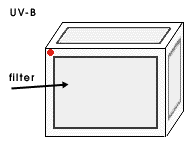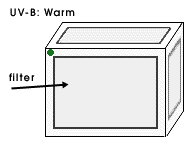

The amount of potentially dangerous ultraviolet (UV) radiation reaching Earth's surface is enhanced by the austral spring depletion of stratospheric ozone, as described in Activity 3.1. Although recent research has demonstrated that increased exposure to solar UV-B radiation (between 280 and 320 nanometers) seems responsible for significant reductions in marine phytoplankton productivity, no research has addressed how enhanced exposure to UV-B affects Antarctic vascular plants, the kind which uniquely grow along the Antarctic Peninsula. In projects conducted in other regions of the world, researchers have found that increased UV-B levels can adversely affect such plants as grasses and forbs (leafy, herb-like plants) and that these plants do not have effective systems for screening UV-B. Along with enhanced UV-B levels, there is evidence that air temperatures along the Antarctic Peninsula have increased over the past 50 years and will continue to do so. It is unclear how Antarctic plants are responding to this warming.
Dr. Thomas (Tad) Day, a botanist from Arizona State University, and his research team are attempting to determine if UV-B and warming temperatures affect photosynthesis, growth and reproduction in the only two vascular plants native to Antarctica, Deschampsia antarctica (a grass), called "antarctic hair grass", and Colobanthus quitensis (a forb), called "antarctic pearlwort". At various sites around Palmer, they'll be using filters to remove UV components from sunlight over naturally growing plants, and using different filters, transparent to UV, to warm other plants as controls.
This Activity allows your students to replicate, in class, Day's experiment, and compare and contrast their results with other students across North America, observing changes across time, as the seasons change. Please note: you may wish to delay this Activity until spring in your region, since it must be done outdoors, where no window glass will filter UV and so interfere with the experiment.
Our thanks to Dr. Day for his input to this Activity, and for reviewing the science.
Objective
Students will conduct an experiment which investigates the effects of UV-B exposure and warmth on seed germination and plant growth.
Materials
Review Electromagnetic Spectrum/light wavelengths/nanometers with class.
Place chemical equation for photosynthesis on blackboard. Ask students if they know what these symbols represent. Some students may easily recognize symbols for water and carbon dioxide.
Read Tad Day's on-line Biography and Field Journal aloud to class. Explain that students will be simulating his Antarctic research back in North America.
The equation for photosynthesis can be written as follows:
6CO2 + 6H2O + sunlight --> C6H12O6 + 6O2
Photosynthesis is the process by which plants produce their own food (C6H12O6). They use energy taken from sunlight to transform carbon dioxide, taken from the air, and water, taken from the soil, into carbohydrates. The rate of photosynthesis is governed by many factors, including temperature and light. In this experiment, students will filter the amount of ultraviolet light (UV-B) plants are exposed to, and observe the effect of this filtering on plant growth. They will also observe the effects of solar warmth on plant growth.
Review experimental procedure. Ask students to hypothesize possible effects of filtered UV-B light and solar warmth on seed germination and plant growth. Record all hypotheses on chart paper.
Also note that two variables will be manipulated in this experiment: the amount of ultraviolet radiation, and solar warmth. Students should discuss how best to control all other variables (seeds, water, environmental factors, etc.)
Procedure



Students can estimate the Total Leaf Area for each plant by:
Tells how students can take part in EPA's on-line Ozone Depletion Art
Project.
http://www.epa.gov/ozone/art/enter.html
![]()
![]()